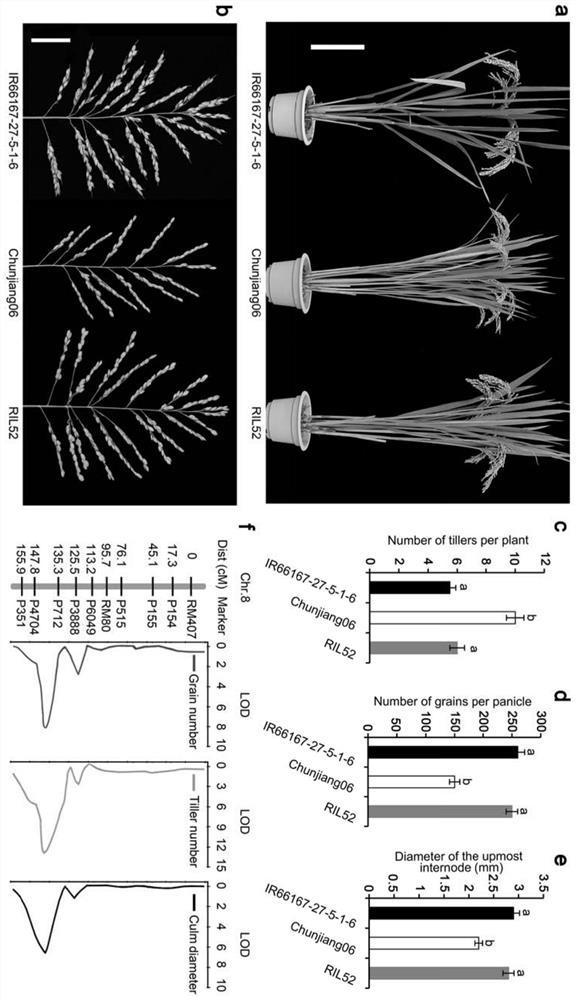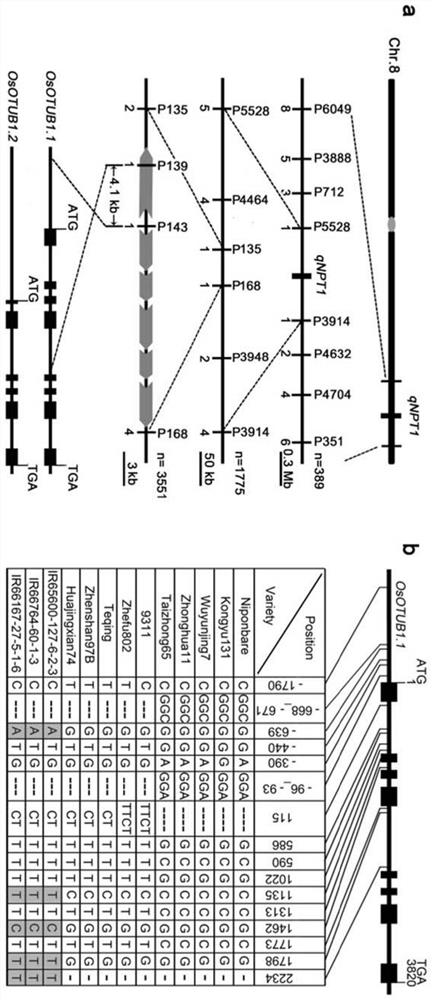An ideal plant type gene npt1 for controlling rice stem thickness, tiller number, grain number per ear, 1000-grain weight and yield and its application
A technology for the number of grains per ear and the number of tillers is applied to genes for increasing the thickness of rice stems, the number of grains per panicle per panicle, 1000-grain weight and yield and its application fields, and can solve the problems of unsatisfactory increase in yield and the like.
- Summary
- Abstract
- Description
- Claims
- Application Information
AI Technical Summary
Problems solved by technology
Method used
Image
Examples
Embodiment 1
[0075] Example 1: Cloning of rice ideal plant type gene NPT1
[0076] The inventors crossed the Chinese japonica rice variety Chunjiang 06 with the ideal plant type strain IR66167-27-5-1-6 of the International Rice Institute to harvest F 1 , and a recombinant inbred line was obtained by the single-grain propagation method; the RIL52 strain had an ideal plant-type phenotype with increased stalk thickness, slightly reduced tiller number, and significantly increased spike number ( figure 1 a-e). F 1 , F 2 The leaves of 196 individual plants were randomly selected from the progeny to extract DNA, and the traits such as the thickness of the stem in the middle of the last node, the number of tillers, and the number of grains per panicle were investigated accordingly. Polymorphism analysis of RIL52 and Zhefu 802 was carried out using SSR primers, and polymorphic primers were selected to target 196 F 2 Individual plants were amplified by PCR. According to the electrophoresis resu...
Embodiment 2
[0080] Example 2: Construction of a near-isogenic line in the background of Zhonghua 11
[0081] The inventors continuously backcrossed Zhonghua 11 with RIL52, selected plants with thickened stems, reduced tillers, and increased grains per panicle, and used the InDel molecular marker P135 to track and detect the target segment; The background scanning was carried out in this section, and the near-isogenic line ZH11-npt1, which was very close to the genetic background of Zhonghua 11, was finally obtained for subsequent research. ZH11-npt1 showed the phenotypes of thick stems, reduced number of effective tillers and increased number of grains per panicle at late filling stage. Further statistical analysis found that compared with ZH11 wild type, ZH11-npt1 internode stalk thickness increased significantly, the number of effective tillers decreased by about 2, the panicle length was slightly shorter (18-20cm in length), and the number of grains per panicle increased by 50 -70 gra...
Embodiment 3
[0082] Example 3: Functional Verification of NPT1
[0083] Extract the roots (root), young stems (culm), leaves (leaf blade), leaf sheaths (leaf sheath), apical meristem (SAM) of a pair of near-isogenic seedlings of the background of Zhonghua 11, 0.2cm The total RNA of young panicle (young panicle), 6cm panicle and 12cm panicle was reverse transcribed to obtain cDNA, and the expression of OsOTUB1 in different tissues and organs of a pair of materials was detected by quantitative PCR. High level of expression, especially in young ears. Compared with ZH11, the expression of OsOTUB1 in different tissues and organs of ZH11-npt1 showed a certain degree of down-regulation ( Figure 4 ).
[0084] Using the plasmid pB1121 (Chen et al., 2003) as a template to amplify the GUS sequence, recover the GUS fragment and the vector backbone and connect them to form the vector pCAMBIA::GUS-2300; amplify the 2.5kb OsOTUB1.1 promoter sequence, digest pCAMBIA::GUS-2300 was recovered and inserte...
PUM
 Login to view more
Login to view more Abstract
Description
Claims
Application Information
 Login to view more
Login to view more - R&D Engineer
- R&D Manager
- IP Professional
- Industry Leading Data Capabilities
- Powerful AI technology
- Patent DNA Extraction
Browse by: Latest US Patents, China's latest patents, Technical Efficacy Thesaurus, Application Domain, Technology Topic.
© 2024 PatSnap. All rights reserved.Legal|Privacy policy|Modern Slavery Act Transparency Statement|Sitemap



